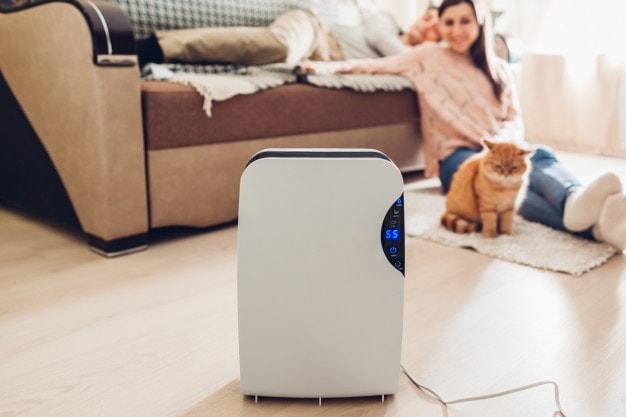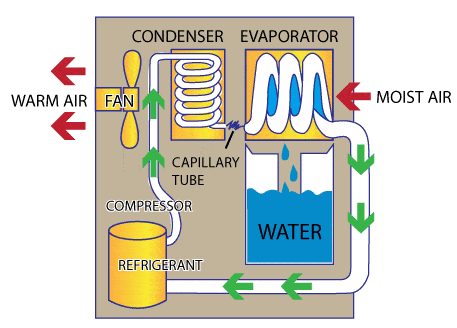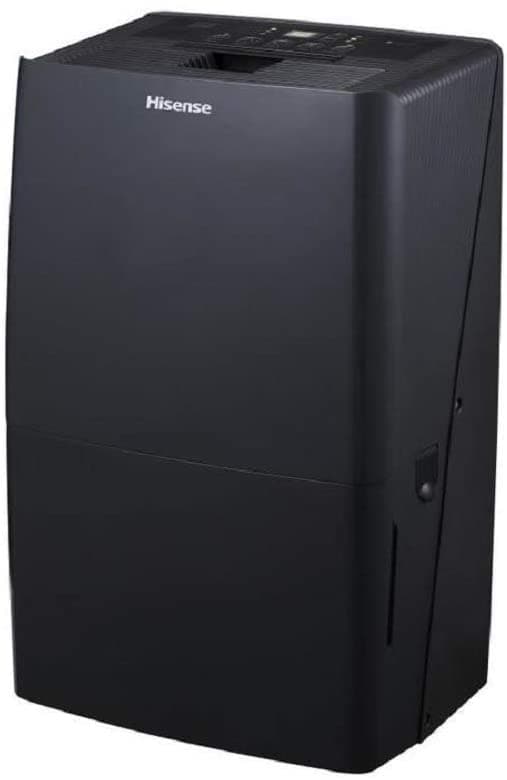Your atmosphere has an enormous impact on your general health. There needs to be a certain level of humidity of about 40-50% to keep your health and comfort at optimum levels.
If these levels are too high, adverse effects like lethargy, low energy, and dehydration are sure to follow, along with the air feeling warmer. In order to avoid this, you need to invest in the best dehumidifier.
The following article highlights everything you need to know about purchasing a dehumidifier.
At a Glance: Our Top Picks for Dehumidifiers
- OUR TOP PICK: Shinco SDO-40P
- RUNNER-UP: Hisense DH7019K1G
- JHS D025B-35PT
Comparison Chart of the Best Dehumidifiers
| IMAGE | PRODUCT | |
|---|---|---|
Our Top Pick  |
| View Latest Price → |
 |
| View Latest Price → |
 |
| View Latest Price → |
 |
| View Latest Price → |
 |
| View Latest Price → |
How to Choose a Dehumidifier
There are certain things to look into once you have decided to purchase a dehumidifier.
Humidity Levels
First, you must be aware of the humidity levels. Are you really in need of a dehumidifier? If humidity is affecting your household items like wooden work and if it is aggravating allergies and flare-ups of chronic asthmatic people, then a dehumidifier is a good option to invest in.

Space Demands
Next, you need to be aware of the space available. How much of the area needs dehumidification? Your pint capacity is largely dependent on the severity of humidity and the space available. The drain hose attachments must be looked into as well. The output of the condensed water should be smooth for the dehumidifier to work at its optimum levels. The drain hose attachment lessens the burden of continuously emptying the water reservoir. If it is not present, then a dehumidifier with an automatic shut off system when the water tank fills is useful.
What Added Features Are There?
After looking into the basics, see if the dehumidifier has additional features. The option of ducting is key when you have more than one room to cater to. Wheels and handles must be kept in check to provide mobility and ease of handling.
Review of the Best Dehumidifiers
Even once you have your list of essentials ready, choosing a dehumidifier from a sea of brands is not easy. There are many variants of the same old dehumidifier available. The trick to get to your dream dehumidifier is to know what you are looking for. You will have to compare every dehumidifier and notice which one has the fewest shortcomings.
To help you further, here’s a list of some of the best humidifiers available today.
Best Overall
Shinco SDO-40P

Product Ratings
Affordability:
Cost Efficiency:
Warranty:
Space Efficiency:
Portability:
How We Determined These Scores
We may earn commission from purchases made from our links, at no additional cost to you
Quick Product Specs:
Pints (DOE): 40
Warranty Length: 1 year
Size & Weight: 11.5×7.48×19.73”; 27.4 lbs.
Tank Capacity: 2 Liters
Decibel Level: 48 dB
Review
The top spot on the list of dehumidifiers is taken by the Shinco SDO-40P and with good reason. Boasting a 5-star cost efficiency rating, this unit provides superb dehumidifying power that can treat your entire home, basement, or RV.
It also has a 4.5-star space efficiency rating which makes it an even better option if you prize efficiency over all else. A 4-star ranking in both portability (via casters and handles) and affordability also means that you can get great dehumidifying power with all of the extra features that other units don’t offer.
Bottom Line
Aside from the top-notch rankings mentioned above, the Shinco SD0-40P also offers a variety of unique features that make it a winner in almost every manner. Multiple drainage options and a quick-drying feature are ideal for smaller spaces or RVs, while a 24-hour timer gives you even more control over the unit. While a 2-star warranty is a drawback, the Shinco checks all the other boxes, making it an overall winner and the belt holder of the best overall dehumidifier.
Pros
Two drainage options
Programmable 24-hour timer
Up to 2,000 sq. ft. of coverage
360-degree rotation via four casters
Quick-drying option that’s ideal for clothes or an RV
Cons
Can be too loud for bedrooms
Self-draining feature is prone to clogging
Runner-up
Hisense DH7019K1G

Product Ratings
Affordability:
Cost Efficiency:
Warranty:
Space Efficiency:
Portability:
How We Determined These Scores
We may earn commission from purchases made from our links, at no additional cost to you
Quick Product Specs:
Pints (DOE): 70
Warranty Length: 2 years
Size & Weight: 16x12x25”; 45 lbs.
Tank Capacity: 6.62 Liters
Decibel Level: 46 dB
Review
The Hisense DH7019K1G earns a 10-star rating along with the Shinco, boasting solid marks across the board. What makes this unit stand out, however, is its added features. With a 70-pint capacity, it’s the most water-absorbent of the bunch, even though it covers just 1,000 sq. ft. That said, it still gets a 5-star cost efficiency rating to go along with a 3.5-star space efficiency rating.
Add in a 3-star warranty and a 4-star affordability rating, and this Hisense dehumidifier is everything you need in one complete, fine-tuned package.
Bottom Line
One of the major hindrances of the Hisense DH7019K1G is that it’s not exactly easy to move. Heavier weight and a lack of handles or casters mean you have to lug this 45-pound unit where you want it, which is less than ideal and provides only a 1.5-star rating for portability. But if you’re a strong individual or you don’t need to move the dehumidifier regularly, you’ll love everything this 70-pint unit has to offer.
Pros
70-pint capacity
Three fan speeds, but still low noise
Included drain hose for easy drainage solutions
Visual and aural cues to change water bucket and filter
Faster, more efficient air removal than other comparable units
Cons
Smaller coverage area of just 1,000 sq. ft.
Constant running of the unit can cause durability and longevity problems
JHS D025B-35PT

Product Ratings
Affordability:
Cost Efficiency:
Warranty:
Space Efficiency:
Portability:
How We Determined These Scores
We may earn commission from purchases made from our links, at no additional cost to you
Quick Product Specs:
Pints (DOE): 50
Warranty Length: 1 year
Size & Weight: 10.2×13.8×19.7”; 34.2 lbs.
Tank Capacity: 4 Liters
Decibel Level: 53 dB
Review
The JHS D025B-35PT is only a 50-pint unit, but that doesn’t mean it lacks compared to larger units, such as the Hisense listed above. What makes this unit a formidable beast is the 4,500 sq. ft. of coverage, which earns this dehumidifier a 5-star cost efficiency rating as well as a 4.5-star space efficiency rating.
On top of its pure efficiency, the JHS also has Intelligent Humidity Control, which is a proprietary technology that always ensures your room or home has the best humidity levels for your needs. Top it off with an easy-to-use interface and automatic features for defrosting and restarts, and this is one of the top units money can buy.
Bottom Line
If you have a larger home, a sprawling basement, or a commercial space, the JHS D025B-35PT is a great option for dehumidification. While the overall ranking suffers due to a 2-star warranty that’s below some of the other options, it has a 3.5-star portability rating that ensures that you can move this unit just about anywhere.
Pros
Thermal overload and fuse protection
Defrost, auto-shutoff, and auto-restart features
Interface is easy-to-use, even for novice owners
Indicator light warns you when to change the water bucket
Keeps your room at the perfect humidity thanks to Intelligent Humidity Control
Cons
Very low tank capacity, which may require frequent changes
Loud operation at high fan speeds makes it less than ideal for bedrooms or living areas
Honeywell TP50WKN
Product Ratings
Affordability:
Cost Efficiency:
Warranty:
Space Efficiency:
Portability:
How We Determined These Scores
We may earn commission from purchases made from our links, at no additional cost to you
Quick Product Specs:
Pints (DOE): 50
Warranty Length: 5 years
Size & Weight: 10.5×13.2×20.1”; 34 lbs.
Tank Capacity: 3.3 Liters
Decibel Level: 50 dB
Review
The name Honeywell is synonymous with great products, and the TP50WKN doesn’t disappoint. Featuring a best-in-class LED display and a cord winder, it has unique features that other units just can’t compete with. More impressively, the 5-star warranty gives you peace of mind compared to lesser-known brands, while a 4-star cost efficiency rating and a 4.5-star space efficiency rating showcase just how powerful this unit is. While it’s a bit more expensive than other options, that’s money well spent.
Bottom Line
One of the biggest downsides of the Honeywell TP50WKN is that it only has a 2.5-star affordability rating and a 3.5-star portability rank. But that shouldn’t sour buyers on the overall quality of this dehumidifier. It’s built like a tank, covers up to 3,000 sq. ft., and provides one of the best dehumidifying experiences overall. If you’re searching for a high-quality option, the Honeywell won’t disappoint.
Pros
Easy-to-use LED display
Up to 3,000 sq. ft. of coverage
Cord winder makes for easy storage
Anti-spill design of the water tank means you won’t spill
Turn-on feature that instantly springs the unit into action when it there’s a rise in humidity
Cons
More expensive than other units on the list
Hose connector is flimsy and can suffer from drainage issues
Shinco SDL-30P

Product Ratings
Affordability:
Cost Efficiency:
Warranty:
Space Efficiency:
Portability:
How We Determined These Scores
We may earn commission from purchases made from our links, at no additional cost to you
Quick Product Specs:
Pints (DOE): 30
Warranty Length: 1 year
Size & Weight: 10.08x8x16.34”; 21 lbs.
Tank Capacity: 1.25 Liters
Decibel Level: 39 dB
Review
A 30-pint dehumidifier doesn’t often reach the ranks of larger units, but you can shrug that aside with the Shinco SDL-30P. Offering 4.5-star ratings in both cost efficiency and space efficiency, this dehumidifier has surprising coverage of up to 1,500 sq. ft, making it ideal for small homes, garages, and basements. And with built-in, lift-up handles, it also gives that little extra bit of versatility, providing a 4-star rating for portability.
Bottom Line
Perhaps the only major downfall of the Shinco SDL-30P is that it lacks a great warranty, providing just 2 stars in that category. But all of that aside, the SDL-30P is a great choice for smaller areas or those that only need 30 pints of dehumidifying power.
Pros
Super quiet operation
Two adjustable fan speeds
Up to 1,500 sq. ft. of coverage
Lift-up handles provide excellent portability
Auto-restart feature makes sure it’s always humming along
Cons
Drainage tube is prone to clogs
Power cord and drainage tube are a bit on the short side
What is a Dehumidifier?
A dehumidifier is essential in your household as it will not only aid in your sleep, but will also keep harmful bacteria, mold, and dust mites at bay. A dehumidifier reduces the amount of humidity in your atmosphere to provide comfort and eliminate any stale odors. This prevents the growth of mildew and mold by depriving the air of water. Some people even find it hard to breathe in areas with high levels of humidity. So, a dehumidifier comes in handy at such pressing times.
This electrical appliance maintains humidity levels and has two variants to help in doing so. These are condensate dehumidifiers and desiccant dehumidifiers. The former simply condense the water vapors while the latter uses a substance that absorbs the moisture.
How Does a Dehumidifier Work?
The regulation of humidity by dehumidifiers is done commonly by refrigerant based methods. Mechanics pertaining to this phenomenon circulate around the simple principles of condensation and evaporation.

It works similar to a refrigeration unit; the moist warm air enters the unit and condenses on the cool coils within the machine. Imagine how on a hot day your cold glass of water forms condensation around it. In the same way, the coils in the unit are at a lower temperature, causing the air around them to condense. The condensate is retained, leaving the air cool and moisture-free.
However, note that it is not similar to an air conditioner. The air is slightly re-warmed as it passes over the fan of the dehumidifier, confirming the high efficiency of the dehumidifier, as the dry and warm air draws in more moisture.
What Size of Dehumidifier Do I Need?
There are different sizes of dehumidifiers available in the market. Your purchase is largely dependent on the space needed for dehumidification and the moisture levels in that area.
Large, medium, small, and whole house capacity dehumidifiers are available. If the area is simply damp with occasional staleness, then for 500 sq. ft. to 1500 sq. ft., 40 pints or fewer is perfect. If the area is larger than 2000 sq. ft., then around 41-60 pints prove to be beneficial. Remember, the scenario changes as the moisture levels increase. If you have a relatively smaller area but high humidity, the pints needed to dehumidify increase
Types of Dehumidifiers
Dehumidifiers may seem like simple devices that function all the same, but that isn’t entirely the truth. Dehumidifiers aren’t all the same. There are, in fact, three different types.
Compressor-based Dehumidifier
These humidifiers are usually large-sized, and with the large size, comes greater water holding capacity that can amount to as much as 10 gallons. Given their size and capacity, these dehumidifiers can be used in rooms of all sizes, small to extra-large, and that too at any level of humidity. The only con of these models is that they’re hard to handle and move given their size.
Thermo-electric dehumidifiers
Thermo-electric dehumidifiers, on the other hand, are not as big in size, and neither is their water holding capacity, usually amounting to only a few ounces in a day. Given their size, these models are perfectly portable and easy to store. However, they only work efficiently in small and closed spaces that have comparatively lower levels of humidity.

Desiccant Dehumidifiers
These humidifiers use a substance that absorbs the moisture instead of a compressor or a thermo-electric system like the other two types. Just like thermo-electric dehumidifiers, these devices are also efficient only for smaller spaces that do not need large scale dehumidification.
Conclusion
Dehumidifiers can work wonders for the air around your home, given that you’ve chosen the right one and the best one for your needs. Keep in mind all the types of dehumidifiers that you can choose from, and all the important aspects of the dehumidifier that need to be considered, and you’ll find the job of selecting the perfect dehumidifier to be a lot easier.
People Also Ask
Below are some common FAQs:
The ideal answer to this question is simple. Run it for 24 hours a day. That is also what most brands of dehumidifiers will tell you because that’s the ideal running time to keep the levels of humidity according to your liking.
But that running time won’t be ideal for your unit. If you do run your dehumidifier, you’ll end up spending a lot more than you should be. For the optimal working of your device as well as the optimal humidity levels, you can run your dehumidifier for up to 10-12 hours, and safely so.
Dehumidifiers are not very complicated machines to use. Just a couple of commands, a few settings, and you’re good to go.
Make sure that you place the unit in the most humid room, such that air is allowed to circulate around it. It is essential to make sure that the unit isn’t placed against the wall.
Connect your dehumidifier to a power outlet, turn it on and adjust its settings according to the manual. This may likely include inputting a desired level of humidity. For this, you may need to measure the current level of humidity and evaluate how much dehumidification you need.
Make sure that you close the doors and windows of the room where a dehumidifier is working as open spaces may reduce the efficiency of the units. Moreover, you need to ensure that you regularly check and empty the water tank, and once in a while, pay attention to any required maintenance for the device.
The power used by dehumidifiers depends upon a number of factors such as the type of dehumidifier being used, its size and its use. In general, a standard electric dehumidifier operates at 280 watts-hour, which is a considerable amount of power being used.
A better idea of how much power is used by a dehumidifier can be made by the fact that dehumidifiers use twice as much as electricity annually as a refrigerator would.
You may notice that your dehumidifier is starting to frost up. Do not worry; this doesn’t put your unit at grave risk. This icing is mostly due to the temperature of the room itself, or possibly due to the air flowing through the unit. These problems can be quickly fixed by temporarily shutting down the unit and reviving the airflow through it. If that doesn’t work, you may refer to the provided manual or seek out customer care.
